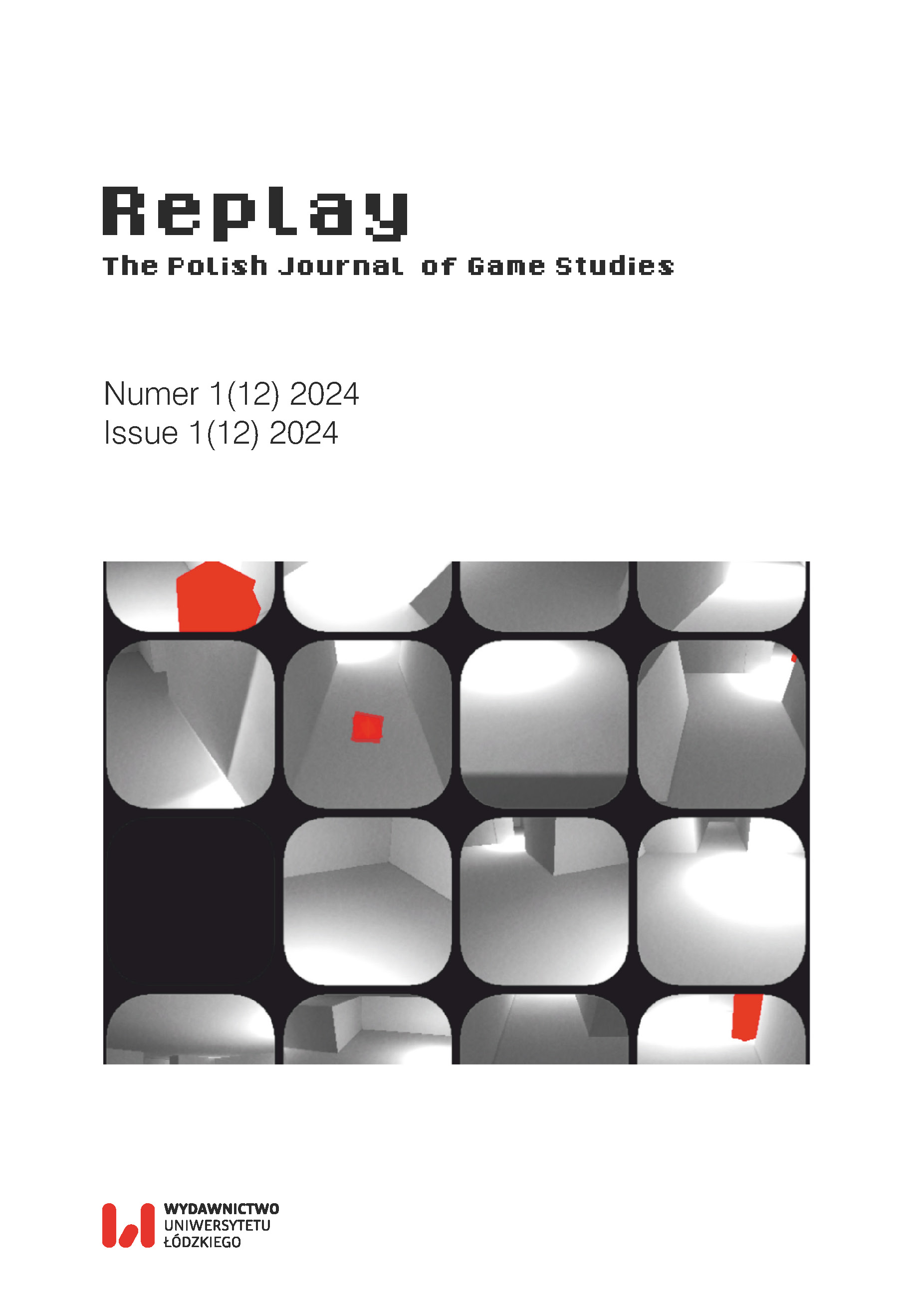Beyond Aesthetics: Players, Player-Characters and Interactivity-as-Demand in Cozy Games
DOI:
https://doi.org/10.18778/2391-8551.12.04Keywords:
cozy game, interactivity-as-demand, player experience, representation, game designAbstract
Cozy games are often defined by their soft visual design, ambient audio, and low risk gameplay that addresses a range of themes from casual to meaningful. Typically, they also center on simple gameplay in terms of control schema and the ability to disconnect, as a safe, relaxing play space, and with its easy exits points to quit the game. While these aspects have been discussed in both scholarly and media entertainment writing, the demands (or lack thereof) have yet to be explored from a theoretical perspective. Through the lens of interactivity-as-demand theory, this paper aims to explore the connection between the gameplay experience as it relates to cognitive, physical, social, and emotional demands and the in-game representations of the player-character. Through this analytical lens, it is possible to understand the consistency and disconnect of demands as experienced by the player compared to how they are (re)presented on screen which has potential implications related to the player’s expectations and design principles of cozy games.
References
Bellingham, H. (2022, July 16). Cozy Gaming: Why a wholesome trend became a recognized genre. Games Radar. https://www.gamesradar.com/cozy-gaming-why-a-wholesome-trend-became-a-recognized-genre/
Google Scholar
Belman, J. (2014). Game Elements: The Language of Values. In: M. Flanagan & H. Nissenbaum (Eds.), Values at play in digital games (pp. 33–72). MIT Press.
Google Scholar
DOI: https://doi.org/10.7551/mitpress/9016.003.0006
Boudreau, K. (2012). Between Play and Design: the emergence of hybrid-identity in single-player videogames (Publication No. NR79156) [doctoral dissertation, Université de Montréal]. ProQuest Dissertations Publishing.
Google Scholar
Boudreau, K. (2019). Beyond Fun: Transgressive gameplay, toxic & problematic behaviour as boundary keeping. In: K. Jørgensen & F. Karlsen (Eds.), Transgressions in Games and Play Anthology (pp. 257–271). MIT Press.
Google Scholar
DOI: https://doi.org/10.7551/mitpress/11550.003.0022
Bowman, N.D. (2018). The demanding nature of video game play. In: N.D. Bowman (Ed.), Video Games: A medium that demands our attention (pp. 1–24). Routledge.
Google Scholar
DOI: https://doi.org/10.4324/9781351235266-1
Bowman, N.D. (2019). Video games as demanding technologies. Media and Communication, 7(4), 144–148.
Google Scholar
DOI: https://doi.org/10.17645/mac.v7i4.2684
Bowman, N.D. (2021). Interactivity as demand: Implications for interactive media entertainment. In: P. Vorderer & C. Klimmt (Eds.), The Oxford Handbook of Entertainment Theory (pp. 647–670). Oxford University Press.
Google Scholar
DOI: https://doi.org/10.1093/oxfordhb/9780190072216.013.34
Calleja, G. (2011). In-game: From immersion to incorporation. MIT Press.
Google Scholar
DOI: https://doi.org/10.7551/mitpress/8429.001.0001
Consalvo, M., & Paul, C.A. (2019). Real games: What’s legitimate and what’s not in contemporary videogames. MIT Press.
Google Scholar
DOI: https://doi.org/10.7551/mitpress/12109.001.0001
Cowley, B., Charles, D., Black, M., & Hickey, R. (2008). Toward an understanding of flow in video games. Computers in Entertainment (CIE), 6(2), 1–27.
Google Scholar
DOI: https://doi.org/10.1145/1371216.1371223
Csikszentmihalyi, M. (1997). Finding flow: The psychology of engagement with everyday life. New York: Basic Books.
Google Scholar
Ćwil, M., & Howe, W.T. (2020). Cross-cultural analysis of gamer identity: A comparison of the United States and Poland. Simulation & Gaming, 51(6), 785–801.
Google Scholar
DOI: https://doi.org/10.1177/1046878120945735
Guajardo, A. (2022). Animal Crossing. In: B. Perron, K. Boudreau, M.J. Wolf, & D. Arsenault (Eds.), Fifty key video games (pp. 21–26). Routledge: New York.
Google Scholar
Hunicke, R. (2005). The case for dynamic difficulty adjustment in games. Proceedings of the 2005 ACM SIGCHI International Conference on Advances in computer entertainment technology, 429–433. https://dl.acm.org/doi/10.1145/1178477.1178573
Google Scholar
DOI: https://doi.org/10.1145/1178477.1178573
Hunicke, R., LeBlanc, M., & Zubek, R. (2004). MDA: A formal approach to game design and game research. Proceedings of the AAAI Workshop on Challenges in Game AI. https://aaai.org/papers/ws04-04-001-mda-a-formal-approach-to-game-design-and-game-research/
Google Scholar
Jiang, C., Kundu, A., & Claypool, M. (2020). Game Player Response Times versus Task Dexterity and Decision Complexity. Extended Abstracts of the 2020 Annual Symposium on Computer-Human Interaction in Play, 277–281. https://doi.org/10.1145/3383668.3419891
Google Scholar
DOI: https://doi.org/10.1145/3383668.3419891
Klevjer, R. (2022). What is the avatar? Fiction and embodiment in avatar-based singleplayer computer games. transcript Verlag, Bielefeld.
Google Scholar
DOI: https://doi.org/10.1515/9783839445792
Moris, S. (2023, April 20). What are cozy games and which are the best ones? Evening Standard. https://www.standard.co.uk/tech/gaming/cosy-games-best-genre-animal-crossing-stardew-valley-b1056844.html (accessed on June 7, 2023).
Google Scholar
Paaßen, B., Morgenroth, T., & Stratemeyer, M. (2017). What is a true gamer? The male gamer stereotype and the marginalization of women in video game culture. Sex Roles, 76(7–8), 421–435. https://doi.org/10.1007/s11199-016-0678-y
Google Scholar
DOI: https://doi.org/10.1007/s11199-016-0678-y
Phelps, A., Consalvo, M., & Bowman, N. (2021) Streaming Into the Void: An Analysis of Microstreaming Trends and Behaviors Utilizing a Demand Framework. Proceedings of the 54th Hawaii International Conference on System Sciences, 2863–2872. http://hdl.handle.net/10125/70963
Google Scholar
DOI: https://doi.org/10.24251/HICSS.2021.349
Short, T.X., Ordon, A., Hurd, D., Howe, C., Forbes, J., Eiserloh, S., Diaz, J., Cook, D., & Meiners, R. (2018, January 24). Cozy games. Lostgarden. https://lostgarden.home.blog/2018/01/24/cozy-games/
Google Scholar
Strampe, L. (2024, January 23). The Best Cozy Games. Wired. https://www.wired.com/gallery/best-cozy-games/
Google Scholar
Tamanaha, E. (2022, May 16). My Top 15 Cozy Games. Medium. https://medium.com/@erinatamanaha/my-top-15-cozy-games-to-cure-a-40-hour-workweek-97657c55e394
Google Scholar
Waszkiewicz, A., & Bakun, M. (2020). Towards the aesthetics of cozy video games. Journal of Gaming & Virtual Worlds, 12(3), 225–240.
Google Scholar
DOI: https://doi.org/10.1386/jgvw_00017_1
Henchman & Goon. (2018). Pode [Nintendo Switch]. Henchman & Goon.
Google Scholar
Nintendo EDP. (2020). Animal Crossing: New Horizons [Nintendo Switch]. Nintendo.
Google Scholar
Robinson-Yu, A. (2020). A Short Hike [Nintendo Switch]. Nintendo.
Google Scholar
Team Ico (2005). Shadow of Colossus [Playstation 2]. Sony Computer Entertainment
Google Scholar
Downloads
Published
How to Cite
Issue
Section
License

This work is licensed under a Creative Commons Attribution-NonCommercial-NoDerivatives 4.0 International License.










